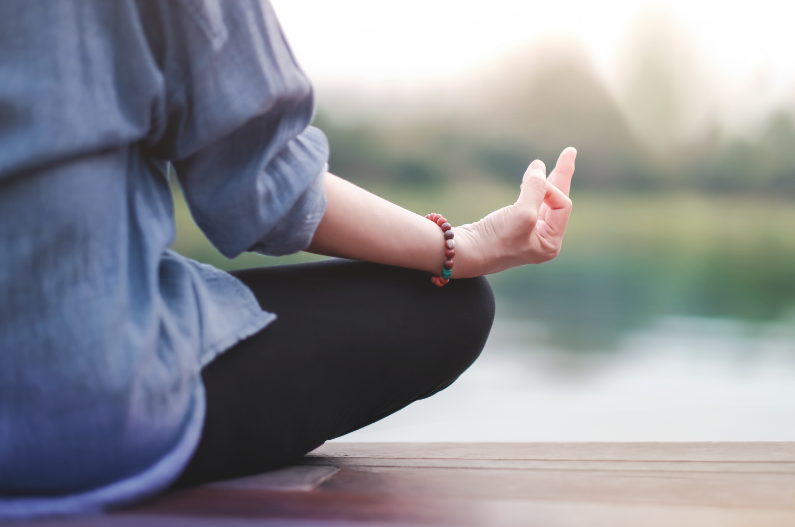Often, meditation is portrayed as a calm, still practice. It can be easy to think that it’s all wise, cross-legged gurus and instant inner peace.
And while meditation can be practiced in a traditional cross-legged lotus pose, it doesn’t have to be. More than that, while meditators may appear calm, sometimes their mind may be anything but.
This article discusses types of meditation and the sensations associated with them. We’ll also talk about some potential feelings, physical and emotional, that meditators may experience.
What is Meditation?
Simply put, meditation is the practice of expanding awareness of the present. It allows us to increase mindfulness, strengthen our ability to handle tough emotions, and connect to our body/mind.
Meditation can be practiced by everyone, regardless of religion or culture. From the Far East to the Midwest, people enjoy its benefits.
We don’t know for certain who created meditation, but it has been around since at least 300 BC.
The Benefits of Meditation
Meditation has many proven benefits, like:
- Stress reduction
- Improved attention span
- Increased self-awareness
- Anxiety control
- Improved emotional health
- Decreased pain
Types of Meditation
There are many meditative practices that serve different purposes. Three examples include:
Mindfulness Meditation
Mindfulness meditation is perhaps the most well-known. The purpose is to observe our thoughts and feelings without judgment or action. This helps us learn to accept things as they are (no matter how uncomfortable).
Ultimately, we learn that we aren’t our thoughts; we don’t need to blindly react to each one we have. And when we do choose to respond, we can do so in a deliberate way.
Imagine sitting in a park on a sunny afternoon, watching the day go by. People walk by, a firetruck’s sirens blare past and the birds sing. We don’t try to change anything, we just sit back and take it all in.
Mindfulness meditation is similar.
To practice:
- Set aside some quiet time.
- Observe the moment, as is. Notice the smells, sights, tastes, sounds and sensations.
- When a judgment arises, acknowledge it and then let it go.
- When overcome with distraction, gently return to observing the moment.
Focused Meditation
This type of meditation helps us improve concentration and attention. It requires that we focus on just one thing. We can choose anything, including a visual item, sound, or physical sensation.
A common focal point is the breath, as it’s always with us. To practice:
- Sit in a comfortable, relaxed position.
- Take 10 deep breaths.
- Focus on the breath. Notice the quality of it (deep or shallow), its sound, the feelings it causes in the body, etc. The goal isn’t to control the breath, only to experience it.
- Bring the attention back to the breath when the mind wanders (which is totally normal).
Movement Meditation
This type of meditation helps us develop body awareness. The most common type is walking meditation.
- Find a location to walk.
- Before beginning, take a few deep breaths.
- Begin walking, slowly and intentionally. With each step, notice the sensations of walking
- Feel each foot lift up.
- Feel how the feet connect with the ground (notice where the heel strikes, the feeling of gravel under foot, etc.).
- Observe how bodyweight shifts while walking.
- Feel the muscles contract and release in the legs and feet.
- Feel how the arms swing.
Walking meditation is often done at a slow pace. However, we can practice anytime, whether going for a run or walking the dog.
What is Meditation Supposed to Feel Like?
As mentioned, meditation has many benefits. But no one can tell us how a personal meditative experience should feel.
The way we experience it is very subjective. As such, there’s no “supposed to” when it comes to meditation.
However, when practicing we may experience certain sensations, both pleasant and otherwise.
Physical Sensations
- Muscle relaxation
- Aches and pains (from sitting for long periods, moving, or pre-existing pain we didn’t notice before practicing awareness)
- Tiredness
- Muscle twitching
- Restlessness (esp. if we aren’t used to sitting still)
- Feeling light-headed or dizzy
Emotional Sensations
- Frustration (Our thoughts and physical sensations can make it difficult to meditate, which can be annoying.)
- Calmness/clarity
- Strong emotions (This may happen in response to thoughts that arise during meditation, or emotions we’ve been repressing.)
- Boredom
- Connectedness to others
- Anticipation/expectation (We may expect certain results. Perhaps we anticipate that meditation will be useless, or that we’ll be interrupted, etc.)
Meditation can be an uncomfortable skill to practice, physically and emotionally. But when we acknowledge the sensations (good and bad), our self-awareness grows.
We learn to accept the present and manage discomfort in a healthy way.
Want to get started with meditation to become a calmer, more capable you? Become a UCA member to gain access to a curated selection of the best meditation resources around!
Sources
https://www.healthline.com/nutrition/12-benefits-of-meditation#11.-Can-decrease-blood-pressure

